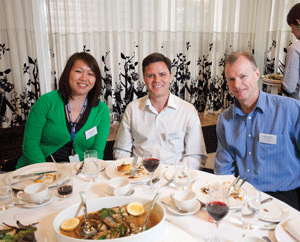What's the Kofax story on enterprise capture?

The Ivy Room is typically the haunt of Sydney's well-photographed media and society celebrities, but for one day it was the venue for a large group of Kofax’s corporate and government customers in Australia, when IDM publisher/editor Bill Dawes (l) took to the stage to interview Martyn Christian (r), Chief Marketing Officer, Kofax. Martyn has over 20 years’ experience in the ECM space and is responsible for product strategy at Kofax.
The 2011 AIIM survey entitled “Capturing Data to Multiple Business Processes - what’s holding you back?” highlights how a scan-to-process capture solution offers organisations a tremendous opportunity to produce cleaner data, higher quality information and better business process management (BPM).
As part of its key findings, AIIM reports that capture is considered to be a vital part of business processes and the return on investment (ROI) of scan-to-process is strong. The paper reports that of the organisations surveyed globally, 62 percent of those organisations scan-to-process projects equalled or improved on the expected ROI payback period through greater productivity, and 60 percent of organisations look to expand their utilisation of a current capture solution. The white paper can be downloaded from www.aiim.org/Research/AIIM-White-Papers/Capturing-Data-to-Multiple-Busin...
IDM: Martyn, the AIIM survey took a look at what is going on with enterprise capture [globally], and I was interested to note that almost 80% of the respondents had a formal mechanism for systematic scanning and capture, and 55% are primarily scanning the process. I don’t have any data to back this up but I would guess this figure is higher than the Australian average. Is this a big opportunity for Kofax?
MC: Obviously in the Australian and New Zealand market here I would say yes, that would be the straight answer. I think that a lot of this is in the eye of the beholder. I’ve been coming to Australia doing business in the ECM world for quite some time, and I always, always found the market here to be much more focused on solutions, one, real value for technology, business process, control management, whatever you want to call it. Not necessarily in the software sense or the technology sense, but just as a whole, I think that the approach here is much more around business processes and around solutions, and getting value for money, and then a real focus on execution. So I suspect that maybe there’s a bigger opportunity here because I would agree those numbers are sort of inflated for this marketplace. So it might take a little longer but when it happens it’ll be done in a much more comprehensive way and a much more solution orientation and business process will be a much bigger part of it. It just won’t be capture for capture’s sake, so, yes; I think it’s a great opportunity, yeah.

IDM: Scan-to-process, which was the focus of this survey, can be implemented in many different areas, invoice processing, medical claims, mortgage and loan applications. What is the killer application that’s really going to drive this and where is the ROI most apparent?
MC: Depending on the type and profile of your business, whether you’re a government agency or you’re a big insurance company, or you’re a banking organisation, whatever, different ones will be more compelling than others. From the research we’ve done over the last 12 months, in this area we think there’s a compelling application that nobody’s really talking about yet, at least in these surveys, and I call it customer on-boarding. Forester Research has done a lot of work in this area. And they’re pretty convinced that customer on-boarding, that whether it’s a government agency bringing in somebody so they can pay them benefits, or whether it’s a bank bringing in somebody so they can lend them money, or whether it’s a manufacturing company bringing in a customer so they can sell them product, that notion of bringing information into your organisation about a new or an existing customer so that you can service them with your product or offering, whatever it may be, we think could be the killer application for this scan to process. Because there’s a lot of processes that sit behind that, the whole CRM set of processes, that whole space, there’s a lot of business processes that sit behind it, and it’s information that you don’t control. So for a new customer you have no control over them until the moment they appear on your website, or the moment they appear in your branch or your retail outlet, or wherever it may be. So I’m not sure whether that’s the right vernacular, but customer on-boarding, I think could be the killer application here.
IDM: One of the survey respondents commenting that “Our processes are mired in a paper that shows no sign of abating.” Now that’s a pretty familiar complaint. The Australian Government’s new Department of Climate Change this year issued a tender for a large storage facility to house 6000 boxes of physical records. Now this is a Federal bureaucracy only created in 2007 which hasn’t so far had anything to do because there’s been no legislation, and has already created of paper records at the rate of 1,500 boxes a year. Now I think that indicates to me that there’s still a way to go for process automation and digital records management and archiving within Government. How does that sort of compare with how you see the Government situation happening in the US and Europe?
MC: I think it’s quite shocking. I believe that there’s a compelling reason for people to do more in this area. Why would you put an organisation together, public or private, and handle paper, if it was a new organisation? Why wouldn’t you adopt the technology and keep your costs low and all the things associated with it? I think in the US the most shocking sort of visualisation of this was 9/11. So you remember when the towers went down the picture that was on the front of every newspaper around the world was the paper just everywhere, in the streets, flying in the sky, which is so much paper everywhere. It was obviously a very shocking, traumatic situation, but it brought home to me that there’s a long way to go in terms of people understanding that there’s a better way of moving information around. I think consumer innovation such as iPods and iPads, and iPhones and then tablets, all that stuff will help. I think that will help people become aware and the new generation become aware. But frankly in the US it’s as bad, if not worse, than the example you gave.

IDM: Should we just send the term “paperless office” into history along with other superannuated clichés, like paradigm shift, the information super highway, and thinking outside of the box?
MC: [Laughing] I don’t know about the last couple there. But the paperless office? I’ve seen it. But it’s only ever by department or by product line. The removal of thousands of files from the business process, I’m not sure whether it’s paperless, but certainly a huge reduction in paper. Is that a paperless office? Because it’s one off, it’s one department, one set of people, one particular business process? I think it probably is. But it’s certainly an incredibly overused term and I think when people say it they’re thinking of something much bigger than what I just described.
IDM: In recent years a lot of organisations have spent a lot of time working to consolidate their ERP systems or bring them into the modern era, and most of the major ERP vendors, SAP and Oracle, have either integrated document management or AP processing, or created alliances specifically for that, how does that leave an opportunity for independent software vendors such as Kofax in that area?
MC: I think that’s a maturing of the industry. If you look back to the database vendor wars and such like, I mean that’s a maturing of a marketplace, that’s embedding of functionality. A number of those organisations embed our capability, so that’s good. That creates business and revenue and profits for us. But I think long term, for the more mature applications, that it will become an embedded function, whether it gets supplied by us as a supplier or somebody else. If you go to salesforce.com, the leader in CRM, SAS model, and you ask them about capturing large amounts of contract information, they will glaze over and you’d have to go and find a third party to do that.
IDM: Many business processes in major industry sectors in Australia, such as manufacturing and mining, which have integrated ERP platforms, are still mired in paper and demand printing and signing at many stages for things such as work orders along the way. Is that a big scan to process opportunity you see there?
MC: There is a Government agency in the UK that maintain the canals and waterways, and they have used our technology and SharePoint, to totally automate the maintenance of that and do it all in a paperless way using tablets, so somebody would be out in the countryside of England walking along a canal, they’d see a bridge, the bridge would be damaged, they’d take a photograph of it, they’d submit it into the Share Point system, it would kick off a job requisition, a job order for it to go and be repaired or maintained or whatever it would be, and all of that done without any paper being created, and very little latency in the process. So from the point where somebody saw it, to the point where the job order was created, was probably seconds, whereas the way they used to do it would have taken them maybe even days. So I think that, that’s one example, but I think that whole area of sort of work orders and maintenance is definitely an area where more of a mobile capture type of solution is pertinent.

IDM: One of the AIIM capture survey conclusions was that the technical difficulties of integration with other enterprise systems are holding back expansion of capture to process projects. Do you think that is an issue still?
MC: I think it is. I think that capture needs to sort of almost grow up and become a first class citizen in the enterprise IT stack. Historically it’s been almost in a dark room, certainly in the scan to archive world it was in a dark room. I think it’s maybe out of that now, and it’s the front end of the business process, but I think ourselves, and maybe our competitors, we need to put more time and money and effort into building our technology so it can be called as a service from any business process anywhere in your organisation. So if you’re in an ERP system and you get to a certain point in an invoice processing application, and you need to capture trailing documents or supporting documents, you can call that as a service, as a first classed web service, and you can go capture that information. We’re not there yet. I mean we have the capability to do that in a few different ways, but I think we need to sort of grow up and invest in that, and become a first class SOA citizen.
IDM: Martyn, it must be a challenge for Kofax working as an independent software vendor with major ECM vendors who have all either acquired or implemented partnerships for capture and workflow and BPM, to offer the whole picture to their clients. How does Kofax deal with that?
MC: We have a great product, and we’ll stand up in a competitive head to head I’m sure. But I also think it’s about a commitment and a focus, and a culture around solving those solutions, solving those problems with capture solutions. So I worked at IBM, it’s a great company, but I know that people at IBM typically don’t wake up every morning and think “How can I make capture software better, and how can I solve more business problems, and how can I save you more money by deploying those technologies?”. They have a very broad range of technology, and that’s their advantage in the marketplace. What we do every morning is we have 400 engineers that wake up and they’re solving capture problems. So if our customers and our business partners need focus, you need real attention to detail on capture problems, and you’re going to get it from a focused vendor.
IDM: I’m graetful to the audience for contributing some questions today, here’s first one: the gap between Kofax Capture and Kofax Transformation Module (KTM) is widening. What is the roadmap there, as you cannot use formation module without using a Kofax Capture click?
MC: The quick answer is yes. We don’t really see those things as two product lines anymore. They came from different heritages, they were developed in different places by different teams, but our plan is really to address those types of concerns by bringing the products together, and having them sort of collapse into a single product from an integration standpoint, from a functionality standpoint, from ultimately probably a licensing and pricing standpoint. But that won’t happen immediately so don’t rush out and ask your sales guy for a quote, because they don’t have the option to do that yet. Those two products are deployed almost seamlessly together most of the time now, certainly by new customers, and so we need to look at that and find a way to integrate them technically and also from a licensing and packaging standpoint. Over the next few months here we’re hoping to make some announcements there.
IDM: With the push for companies to outsource, what are the plans for a multi tenanted platform in KTM?
MC: The way KTM’s built today that’s not something that we could easily do. So what it requires is some R&D work and some reconfiguration. Just before I left to come to Sydney we approved some work to go off and look at that. So we are looking at doing cloud based or services based applications which would include KTM. But that’s probably going to take a while for us to be able to do it in a multi tenanted environment. So if you have that need we’re very interested in talking to you. Our engineers are just going off and starting to do that research work now and if you have a use case, if you know what it is you want to do, whether it’s from a BPO standpoint or it’s from a customer standpoint, we’d certainly like to talk to you and get that information so we can build a use case around it.
IDM: Is Kofax doing any work with the Content Management Interoperability Standard (CMIS) for ECM platforms to work together?
MC: Yes, we are. To the extent that the ECM vendors or repository vendors adopt that, and some have and some haven’t, and some have announced it but not yet delivered it, we’re very interested in doing that. That would make our lives easier. We think it will be a much more standard approach to things, obviously. So, we have approved some work to go off and start working on that. It won’t be available in the next few months, but it’s certainly something we’d like to see on the market.
IDM: Finally, the past six months have been tough on many in the industry, including Kofax. Your CEO, Reynolds Fish, recently acknowledged that market slow down caused by increasing uncertainty and volatility in the global economic environment. He said “We expect these challenges to continue until more confidence and stability returns to the markets”. He was confident that the push for the paperless office would still continue. Do you think there is a sufficient push for this new digital process management culture to keep expanding these projects?
MC: Yes. And I think that the alignment of capture technologies with business process management technologies is going to continue to converge. I think we are at the forefront of that, driving that, and I think that the reason why we’re doing it is it’s all about business value. So capture in its own right, as you saw, great return on investment, but capture needs to be closer to the business processes, you need to be able to see value from it, you need to be able to tie those things together, and if you do that then you’re going to save a lot of money, you’re going to generate more revenue, you’re going to satisfy your customers better. So I think the answer is obviously it’s uncertain times, there’s a lot of pressure on all our businesses, collectively. Our strategy is really to go and drive more value out of the capture technology we have, and do that in a way where we’re tighter linked to your business processes, have more capabilities there, but that’s both software wise, services wise, integration wise, product wise, is to deliver you more there, more value on top of what you do with capture today.
